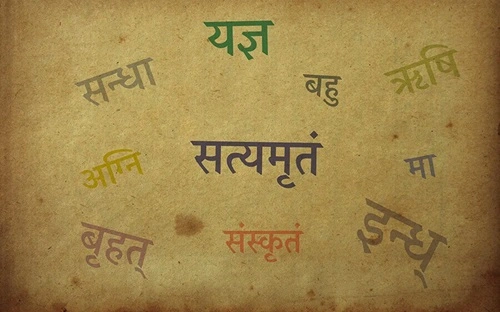Sanskrit, often regarded as the “language of the gods,” is one of the oldest and most influential languages in human history. This classical language of India is not just a cornerstone of Hindu religious texts but also a vital part of the world’s linguistic heritage. With its precise grammar and phonetics, Sanskrit has contributed significantly to the development of many modern languages, both within India and beyond. Though its use has dwindled in daily conversation, Sanskrit continues to thrive in religious ceremonies, literature, and academic circles.
In this article, we explore some fascinating facts about the Sanskrit language that highlight its unique status and enduring relevance.

1. The Oldest Language Known to Mankind
Sanskrit is often considered one of the oldest languages in human history. It is a part of the Indo-European language family, which includes other ancient languages like Greek, Latin, and Persian. The earliest written records of Sanskrit date back to around 1500 BCE, with the composition of the Rigveda, one of the oldest religious texts known to humanity. Sanskrit is thus not only a sacred language but also one of the oldest continually spoken and written languages in the world.
2. The Root of Many Indian Languages
Sanskrit is the root language for many modern Indian languages, including Hindi, Bengali, Marathi, and Gujarati. These languages have borrowed extensively from Sanskrit vocabulary, grammar, and syntax. Even Dravidian languages like Kannada, Tamil, and Telugu, although not directly descended from Sanskrit, have incorporated a significant number of Sanskrit loanwords. Sanskrit’s influence on Indian languages is so profound that many words used in day-to-day conversations have their origins in Sanskrit.
3. Highly Structured Grammar: Panini’s Ashtadhyayi
One of the most remarkable aspects of Sanskrit is its highly structured grammar. The Sanskrit grammar was systematised by the ancient scholar Panini in his work, the Ashtadhyayi, around the 4th century BCE. This treatise contains nearly 4,000 rules governing the grammar and syntax of Sanskrit, making it one of the most comprehensive linguistic frameworks in history. Panini’s work is considered so precise that it is often compared to modern computer programming languages for its logical structure.
4. The Language of Hindu Scriptures
Sanskrit holds a sacred status in Hinduism, being the language in which the Vedas, Upanishads, Mahabharata, Ramayana, and countless other religious texts were composed. The Bhagavad Gita, one of the most important spiritual and philosophical texts in the world, was written in Sanskrit. The language is also used in the liturgical texts of Jainism and Buddhism, making it a key language in South Asian religious and philosophical traditions.
5. Sanskrit Is a Phonetic Language
One of the reasons Sanskrit has endured for millennia is its perfect phonetic structure. Each letter in Sanskrit has a precise pronunciation, and the language has a structured sound system that includes vowels, consonants, and dipthongs. The pronunciation of words remains consistent regardless of where or when they are used. This phonetic purity makes Sanskrit ideal for chanting and recitation, especially in religious contexts.
The Devanagari script, used to write Sanskrit, also has a close relationship with phonetics, where each character corresponds to a specific sound, ensuring that the pronunciation of Sanskrit words remains exact.
6. The Language of Yoga
Sanskrit is the foundational language of Yoga, with most asanas (postures), pranayama (breath control techniques), and mantras being described in Sanskrit. Words like Surya Namaskar (Sun Salutation), Shavasana (Corpse Pose), and Om (the primordial sound) are derived from Sanskrit. Practitioners of yoga around the world use these Sanskrit terms, making it a truly global language in the realm of wellness and spirituality.
7. Sanskrit in Western Science and Linguistics
Sanskrit has had a significant influence on Western linguistics and science. The study of Sanskrit by European scholars in the 18th century helped lay the foundations of comparative linguistics. In fact, the discovery of similarities between Sanskrit, Latin, and Greek led to the formation of the Indo-European language family theory. Notable linguists like Sir William Jones and Franz Bopp were instrumental in advancing the study of Sanskrit, which greatly influenced the field of linguistics.
Additionally, Sanskrit texts contain significant contributions to fields like astronomy, mathematics, and medicine, demonstrating the language’s role in early scientific advancements.
8. Sanskrit and Artificial Intelligence (AI)
Due to its precise grammatical structure, Sanskrit has been studied in the context of artificial intelligence and natural language processing. The algorithmic and rule-based nature of Sanskrit grammar, especially as outlined by Panini, makes it an ideal candidate for computational linguistics. Some scholars believe that Sanskrit’s structure could help in creating more efficient programming languages for AI, given its unambiguous syntax and logical consistency.
9. Revival Movements for Spoken Sanskrit
While Sanskrit is often thought of as a “dead language” used only in religious and academic contexts, there has been a resurgence in efforts to revive it as a spoken language. Several initiatives in India, such as the Samskrita Bharati movement, have been promoting spoken Sanskrit through workshops, courses, and community programs. Villages like Mattur in Karnataka are famous for having residents who speak Sanskrit fluently in their daily lives.
Furthermore, many schools in India and abroad have incorporated Sanskrit as a subject, allowing the younger generation to explore this ancient language.
10. Sanskrit Words in Global Languages
Sanskrit has left its mark on several global languages. Many English words have their roots in Sanskrit, either directly or through other languages like Greek and Latin. For instance:
- Guru (spiritual teacher),
- Yoga (discipline or union),
- Mantra (sacred utterance),
- Avatar (descent or incarnation).
Additionally, Sanskrit words have made their way into other languages like Thai, Balinese, and Indonesian, as well as in many East Asian languages through Buddhist texts.
11. Sanskrit as a Language of Poetry and Music
Sanskrit is known for its musicality and rhythmic beauty. Its rich collection of poetic metres, known as Chandas, makes it one of the most poetic languages in the world. Great poets like Kalidasa wrote timeless epics in Sanskrit, such as the Shakuntala and Meghaduta, which continue to be admired for their lyrical elegance.
Many classical Indian music compositions, especially in Carnatic and Hindustani music, use Sanskrit lyrics, particularly in devotional songs like bhajans and kritis. This demonstrates Sanskrit’s seamless blend of language, poetry, and music.
12. Sanskrit’s Role in Ayurveda
Sanskrit is the language of Ayurveda, India’s ancient system of natural healing. Classical texts on Ayurveda, such as the Charaka Samhita and Sushruta Samhita, are written in Sanskrit. These texts provide detailed descriptions of medical treatments, herbal remedies, and surgical procedures that are still in use today. Knowledge of Sanskrit allows practitioners of Ayurveda to access these original sources and understand the rich heritage of traditional Indian medicine.
13. Sanskrit and its Influence on Names
Many names in India, both for people and places, have Sanskrit origins. Common Indian names like Anjali, Ravi, Vishnu, Lakshmi, and Krishna are derived from Sanskrit words that carry deep meanings. Similarly, names of places such as Bharat (India) and Ganga (a sacred river) have Sanskrit roots. The language’s influence is so pervasive that even modern names are often based on Sanskrit words, reflecting its timeless significance.
Conclusion
Sanskrit is more than just a language; it is a window into India’s ancient wisdom, culture, and history. Its contributions to religion, literature, science, and philosophy are unparalleled, and its influence can be seen in the development of languages and ideas across the world. Although it may not be widely spoken today, Sanskrit continues to thrive through its role in religious practices, scholarly research, and modern-day revival movements.
For anyone looking to explore the roots of Indian civilisation or delve into the complexities of one of the world’s oldest languages, Sanskrit offers a journey into an enduring and vibrant linguistic tradition.


